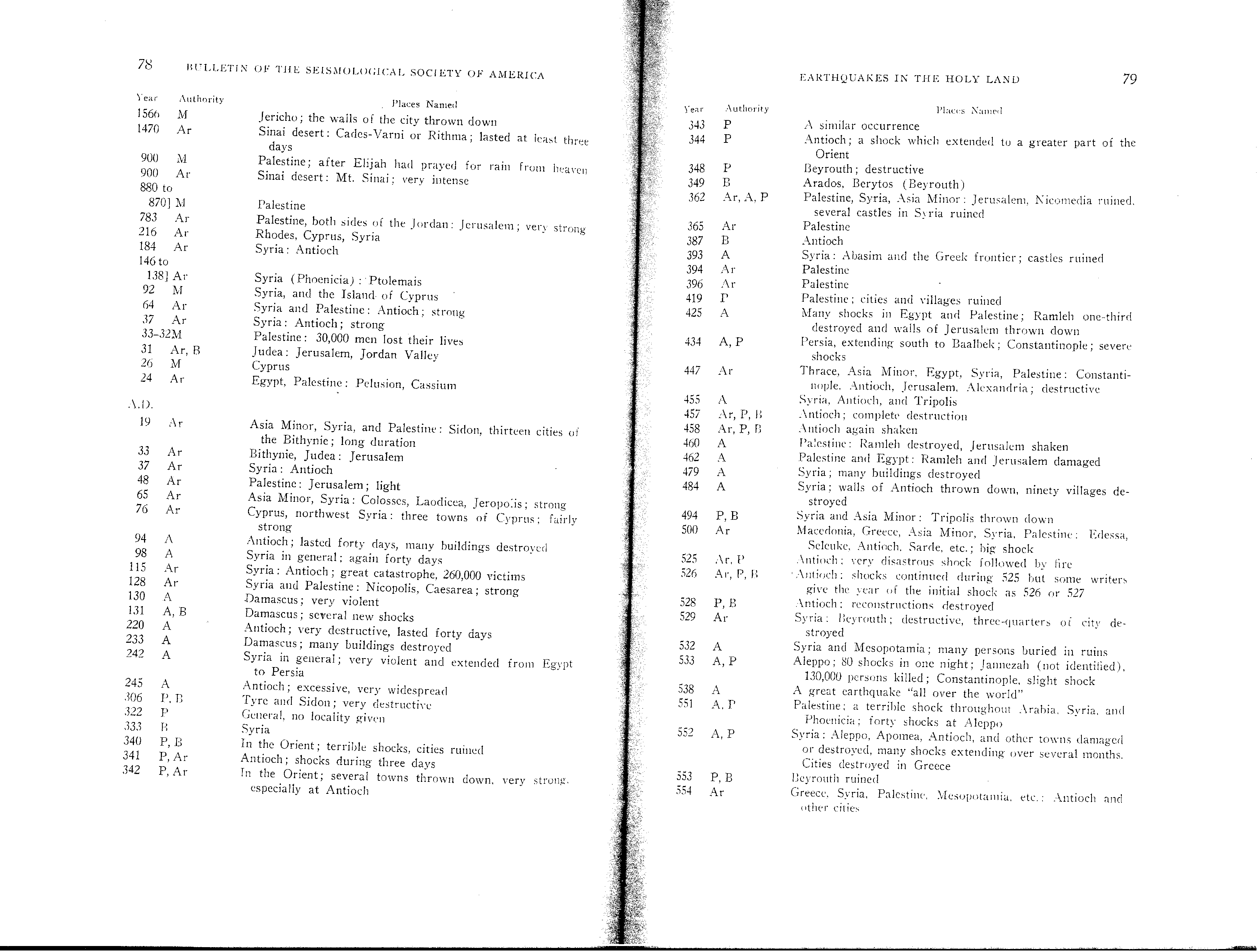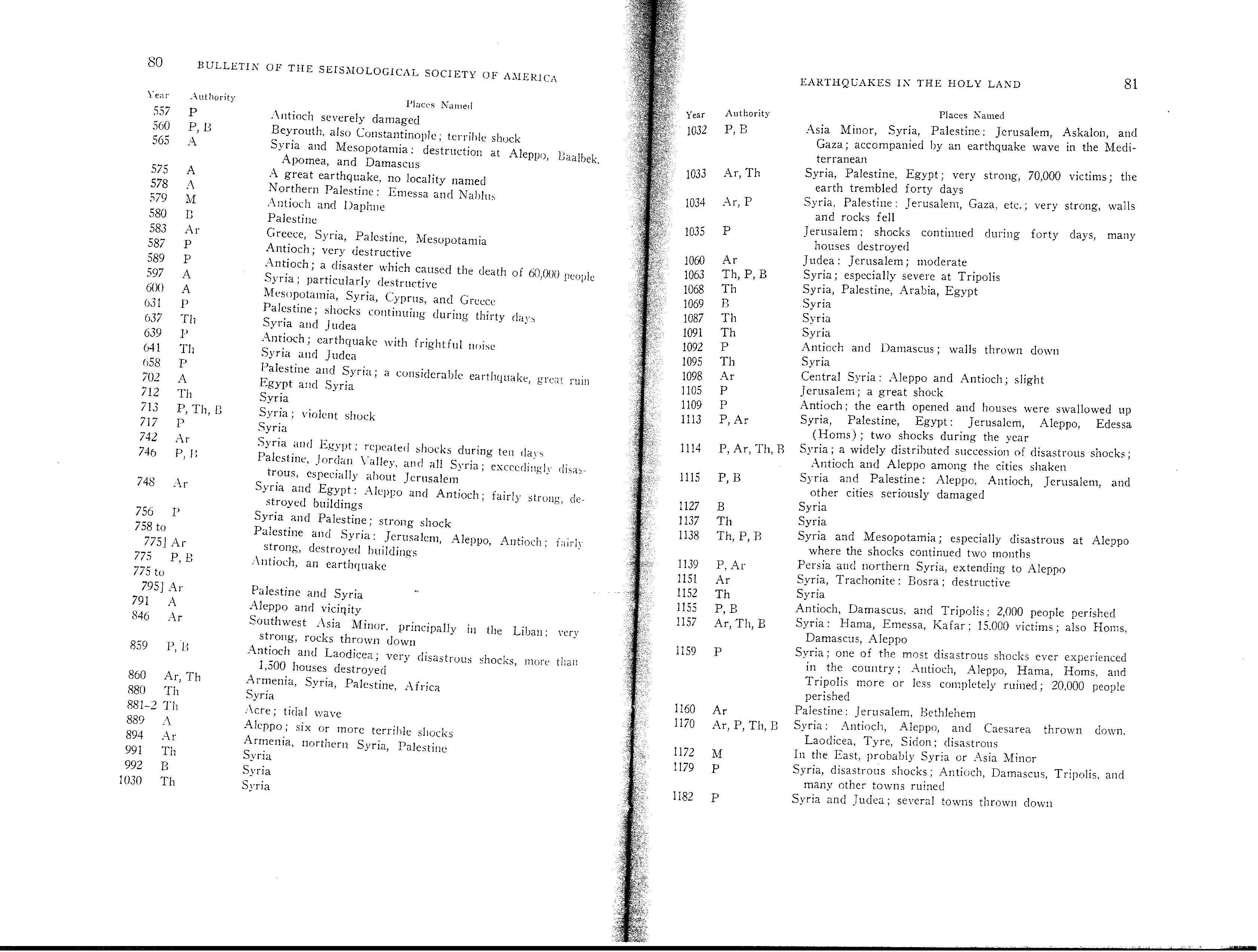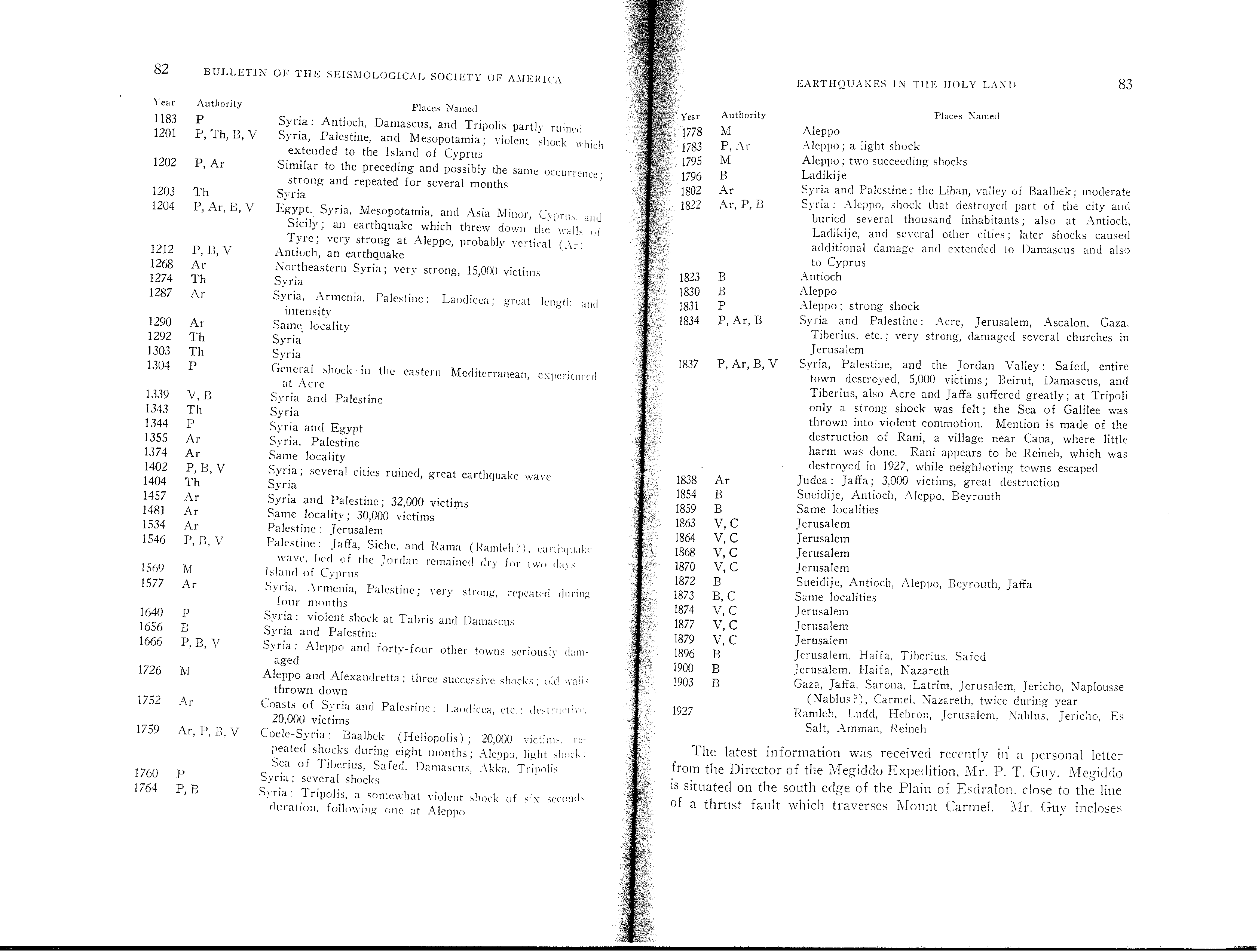Willis (1928) with corrections
Willis' (1928) original catalog mistakenly listed Al Hejira dates from an Arabic language source (originally Al-Soyuti) as Julian calendar dates. Thus a number of earthquake dates in Willis' original catalog are off by around 622-623 years. Willis wrote a correction in 1933. Ambraseys (1962) wrote a later article correcting these errors in detail. Ambraseys (1962) noted that some of Willis' mistaken dates had entered Sieberg's catalog which then propagated into more modern earthquake catalogs and created phantom earthquakes. CHRONOS can be used to convert between Islamic and Julian dates.
- Corrected Dates are in parentheses
94 A.H. (7 October 712-25 September 713)
An earthquake in Syria which lasted forty days. Many buildings were destroyed in Antiochia.
98 A.H. (25 August 716-13 August 717)
Again for forty days, during the Khalifat of Omar Ben Abdul'aziz, in Syria.
130 A.H. (11 September 747-30 August 748)
An earthquake in Damascus which was so violent that people were obliged to leave the town.
131 A.H. (31 August 748-19 August 749)
Several new shocks in Damascus.
220 A.H. (5 January 835-25 December 835)
Antiochia was destroyed by an earthquake which lasted forty days.
233 A.H. 11th Rabi-al-accher (24 November 847)
At Damascus many persons were buried under the houses; the earthquake extended to Antiochia, Mesopotamia and Mausul. It is said that 50,000 persons perished.
242 A.H. Shaban (3-30 December 856)
A very violent earthquake. At Tunis about 45,000 persons were buried under their houses. It extended also to Yemen, Khorasan, Fars, Syria, Bantam, Kommh, Kashan, Rai, eI- Damaghahn, Nishapur, Taberistan and Ispahan. The mountains fell down and the earth opened so extensively that men could walk into it; and in the village of el-Sud in Egypt five stones fell from heaven. One stone fell on the tent of a Bedouvin and set it on fire. The weight of these stones was ten rotles (10 lb). In Yemen a hill covered with fields moved from its place and became the property of another tribe.
245 A.H. (8 April 859-27 March 860)
Earthquakes prevailed over the whole world and many towns and bridges were destroyed.
362 A.H. (12 October 972-1 October 973)
Several castles in Syria were ruined by an earthquake.
393 A.H. (10 November 1002-29 October 1003)
In Syria, Abasim and the Greek frontier many castles were ruined by an earthquake.
425 A.H. (26 November 1033-15 November 1034)
Many earthquakes took place in Egypt and Syria, by which one-third of Ramlah was destroyed. The walls of Jerusalem fell down, and many villages were swallowed up in the ground.
434 A.H. (21 August 1042-9 August 1043)
At Tebris the fortress and the town were nearly destroyed by an earthquake and about 40,000 persons perished. Many also perished at Tadhmor and Baalbek by the same cause.
455 A.H. Shaban (30 July-27 August 1063)
Shahhan; at Wasit, Antiochia, Sul, Laodicea, Akka and over all Syria. The walls of Tripolis were destroyed.
460 A.H. filth Jamadalawwal (18 March 1068)
An earthquake in Palestine. Ramla was destroyed; it extended to the Hejahz. It reached also Wadi-el-Szafrh, Khaiber, Bedr, Yanbah, Wadikora, Teima and Tabuk, and it extended as far as Kufa. Only two houses of Ramla remained and 25,000 persons perished. Haila was destroyed with all its inhabitants. The earthquake was felt also at Jerusalem. The sea receded from the coast, but soon returned again into its place. In all these countries it was felt at the same hour.
462 A.H. 11th Jamadalawwal (25 February 1070)
At Ramla and its dependencies, Jerusalem and Egypt. One corner of the principal mosque of Cairo gave way; it was succeeded by two other earthquakes soon after.
479 A .H . (18 April 1086-7 April 1087)
In Iraq, Mesopotamia and in Syria, many buildings were destroyed by an earthquake.
484 A.H. (23 February 1091-11 February 1092)
In Syria and elsewhere many buildings, ninety villages and the walls of Antiochia were destroyed by an earthquake.
582-4.H. (19 September 1137-7 September 1138)
An earthquake in Syria, Iraq and Mesopotamia; many persons were buried under the ruins.
533 A.H. (8 September 1138-27 August 1139)
130,000 persons lost their lives. Jannezakh sunk and the spot was covered with black water for the distance of ten farsangs (37 miles); also Aleppo suffered eighty shocks in one night. It was felt over all the world, but strongest in Aleppo.
538-4.H. (16 July 1143-3 July 1144)
Great earthquake over all the world.
551 A.H. 2nd Shawwal (18 November 1156)
Several earthquakes took place in Syria. In the same year there was a great earthquake which was preceded and followed by others. At Aleppo, Hamat and many other places, there were about forty shocks. It was one of the most tremendous earthquakes (as-Soyuti then gives the dates of nine earthquakes which occurred in 551 AH without referring to a particu. lar place).
552 A.H. (13 February 1157-1 February 1158)
On the night of the 19th Safar (2 April 1157) a great earthquake took place which was followed by another shock; a third one occurred in the night of the next day and following day in Syria. In the night of the 25th Jumadaawwal (5 July 1157) four shocks. In the night of the 4th Jumada-el-accher (14 July 1157) several shocks, particularly at Aleppo and Emessa, where they were destructive; also in Hamat, Kafertab and Taima. In the 4th of Rajab (12 August 1157) at day time at Damascus it was so violent that never the like had been seen; it caused some destruction. In the night of Friday the 8th of Rajab (16 August 1157) there were three earthquakes which were followed by others on Saturday, Sunday and Monday night, and several shocks after that. It did great damage in Hamat Shiraz and Emessa. In Damascus it did not begin before Monday the 29th of Rajab (6 September 1157) but caused great consternation. Another earthquake took place on the 24th of Ramadan (30 October 1157) which was terribly felt at Aleppo and Hamat (Apamea) where it continued for sometime with intermissions. In the night of Saturday the 10th of Shawwal (15 November 1157) and in the night of the 10th of Dhul'qada (14 December 1157), and on the night of the 23rd and 25th of the same month people were so frightened by earthquakes that they took refuge in the fields. Apamea was destroyed.
565 A.H. (25 September 1169-18 September 1170)
An earthquake in Syria, Mesopotamia and almost all the world; it destroyed many walls and houses in Syria, more particularly at Damascus, Emessa, Apamea Aleppo and Baalbek.
575 A.H. (8 June 1179-27 May 1180)
A great earthquake.
578 A.H.
This is a misprint in Sprenger's translation. The year should read 598 A.H.
597 A .H. (12 October 1200-30 September 1201)
There was an earthquake almost over all the world more particularly in Upper Egypt, where it caused great destruction; it extended over Syria and the sea, Mesopotamia, the Greek empire and Iraq; it was particularly destructive in Syria. It was also felt in Armenia, Azerbaijan and it is calculated that through this earthquake 1,100,000 lives were lost. The first shock lasted but a short time, but after that it continued for several days, and it seems that it came from Mesopotamia to the sea-coast.
598 A.H. Shaban (26 April-24 May 1202)
At Emessa, the castle of the Kurds was destroyed; it extended as far as Nablus.
600 A.H. (10 September 1203-29 August 12 04)
An earthquake in Egypt, Mesopotamia, Mausul, Iraq the Greek empire and Cyprus; it extended as far as Sabta in the Maghrib.
702 A.H. (26 August 1302-14 August 1303)
On the 23rd of Dhul'hijja (8 August 1303) Thursday in Egypt and Syria, many persons were buried under the ruins, and all Alexandria was submerged under the sea.
791 A .H. (31 December 1388-19 December 1389)
At Nishapur violent wind and earthquake; many people perished.
889 A.H. Rabi-al-awwal (29 March-27 April 1484)
Six or more terrible shocks at Aleppo.
NOTE. Toponymics, Provinces, Departments etc. have during historical times had many changes. The names used by As-Soyuti are a mixture of Arabic and corrupted Greek. A useful set of volumes in tracing out places in Syria, Palestine and Egypt is Abul-feda's Geography translated from the Arabic by M. Reinaud and S. Guyard (Geographie d'Aboulfeda, 2 Volumes, a l'Imprimerie Nationale, Paris 1848).
Ambraseys, N. 1961. The Seismicity of South-West Asia; Data from XV-century Arabic MS," Revue pour l'Etude des Calamites, No. 37, Geneva.
Calvisius, Sethus 1650. Opus Chronologicurn, 4th Edition by Anth. Hummius, Francofurti ad Moenum a Embdae.
Cedrinos, Georgios c. 1200 Cedrinos Georgios Historiarum Compedium by B. Niebuhrii, Corpus Scriptorum Historiae Byzantinae, Bonn. (also Theophanes, Glycas, etc.)
El-Macin 1625. Historia Saracena, Ed. Erpenius, Leyden.
Sieberg, A.
1932a. "Untersuchungen caber Erdbeben und Bruchschollenbau in ostlichen Mittelmeerge- biet," Denkschriften der Medizinish-Naturwissenschaftlichen Gesellschaft zu Jena. Vol. 18, Jena.
1932b. "Die Erdbeben," in Gutenberg's Handbuch der Geophysik, vol. 4: Part 5, pp. 794, Berlin.
Sprenger, A. 1843. "As-Soyuti's Work on Earthquakes Called Kashf as-Salzalah an Wad Az-zalzala,h, translated from the Arabic," J. of the Asiatic Soc. Vol. 12, No. 141, pp. 741, Calcutta.
Willis, B. 1928. "Earthquakes in the Holy Land," Bull. Seism. Soc. Am., 18: 77.
Wiistenfeld, F. 1903. Vergleichungs tabellese der Muhammendanischen und Christlichen Zeitrechwungen Ed. F. A. Brockhaus, Leipzig; also Edition (1926) revised by E. Mahler, Leipzig. Cf. . Comparative Tables of Muhammadan and Christian Dates by W. Haig, Ed. Luzae, London, 1932.




AMBRASEYS, N. N. (1962). "A note on the chronology of Willis's list of earthquakes in Palestine and Syria." Bulletin of the Seismological Society of America 52(1): 77-80.
Willis, B. (1928). "Earthquakes in the Holy Land." Bulletin of the Seismological Society of America 18(2): 73-103.
Willis, B. (1928). "Earthquakes in the Holy Land." Bulletin of the Seismological Society of America 18(2): 73-103. - another link
Willis, B. (1933). "Earthquakes in the Holy Land: A Correction." Nature 131(3311): 550-550.
